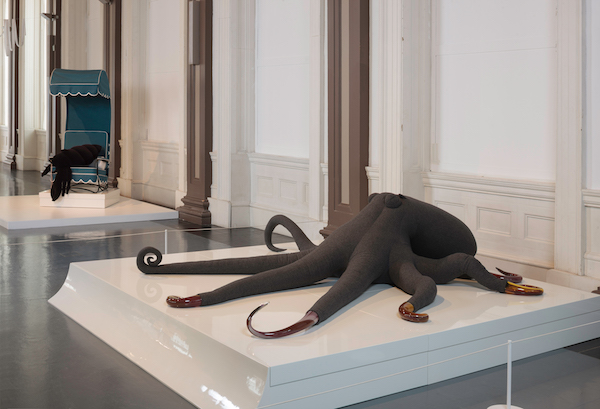
Photo: Ruth Clark.
Installation view of Helen Johnson’s work at Glasgow International.
Photo: Ruth Clark.
Glasgow International, which opens today, features work by over 200 artists, and explores themes relating to the city’s industrial heritage, the production of value, and the resurgence of interest in hand making and craft skills. What remains unspoken, but is perhaps more striking than any of the festival’s stated areas of enquiry, is the significant proportion of work by female artists featured. And not just in the director’s program—in which women artists outnumber men by 10 to four—but across the entire city-wide festival.
That this should be at all noteworthy speaks ill of gender balance within the wider art world—whether at the level of institutional exhibitions, small gallery shows, or art magazine cover stars.
Sarah McCrory, director of Glasgow International.
Photo: Ruth Clark.
“If it was weighted the other way it wouldn’t even have been noticed,” says director Sarah McCrory, whose curated segment of the program includes significant commissions by Sheila Hicks, Helen Johnson, Claire Barclay, Tessa Lynch, and Alexandra Bircken, as well as a survey exhibition by Cosima von Bonin.
Speaking in March during preparations for the festival, McCrory said she felt it was “an important time to be recognising that it’s not ok to be making exhibitions that have a long list of white men in them.”
Installation view of Cosima von Bonin’s work at Glasgow International.
Photo: Ruth Clark.
With the festival opening to the public today, McCrory clarifies that “it wasn’t a decision to select a large majority of women artists” but something that occurred naturally following her research into work that addressed themes such as feminist practices and labour. “[The program] is not balancing practice at the expense of anything,” she explains. It’s about the merit of the work.”
“I don’t see Sarah as having set out to do a women’s program—she’s set out a program that’s intelligent and sophisticated, many of the artists in which happen to be women,” says Melbourne-based artist Helen Johnson, whose subtle, bannerlike paintings are suspended within the crumbling Kelvinhall.
Johnson has elsewhere encountered curators nervous about including too many female artists in one exhibition and points out how acceptable it remained for the gender balance to be tilted violently in the other direction: “It wouldn’t be read as an all-male show—it would just be read as a show,” she adds.
Installation view of Helen Johnson’s work at Glasgow International.
Photo: Ruth Clark.
Johnson cites CoUNTess, a blog run by Elvis Richardson reporting on gender balance in Australia’s art world. The CoUNTess Report not only tallies in favour of men year on year, but also uncovers subtler imbalances—women artists winning more awards than men, but lower prize money, for example.
“There’s certainly a process in Australia where white male artists are anointed and swept into this updraft and become very desirable,” says Johnson. “Women artists will get collected but not swept into those same career trajectories that almost become like a cult of personality.”
“I don’t think it’s important that this should be highlighted,” says Alexandra Bircken who has created new works responding to Glasgow’s Tramway space. But she admits that she does see “a very different situation” for male and female artists (including “much more pressure to look the part”). “The higher you get with shows, and the more institutional, the less women there are around,” Bircken says. “The question is whether it will ever go away and be balanced out?”
Installation view of Alexandra Bircken’s work at Glasgow International.
Photo: Ruth Clark.
McCrory, who says that she still regularly receives invitations to exhibitions that are “twelve white men strong” sees social media sites like Facebook as providing important “safe spaces” to call people to task. “It’s important that everyone is realizing that we’re failing to represent our communities—there has to be an active shift in representation.”
The 2016 edition of Glasgow International is on view from April 8-25 across several venues in Glasgow, Scotland.